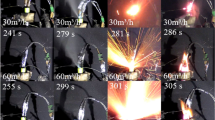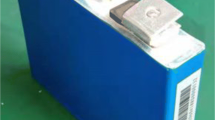Abstract
The frequent accidents of power lithium-ion battery have become the major reason to hinder the development of electric vehicles. In this paper, the thermal runaway process for a 32650 battery is analyzed based on 300°C oven heating experiment in adiabatic rate calorimeter, the rise of temperature, the drop of voltage and the leakage of electrolyte are observed before exploding, which could be used as predictor variables for thermal runaway warning. A large number of smoke releases and diffuses after explosion, which could be utilized as a criterion for determining the explosion. And a lumped chemical reaction kinetics model coupled with three-dimensional heat transfer model is constructed for further discussion. The thermal runaway process of the battery could be accurately calculated by the coupled model. Thermal radiation plays a more important role in heat transfer than heat convection in the process of thermal runaway. The explosion happens when the temperature achieves around 230°C, and the active material mainly starts to decompose at this moment.














Similar content being viewed by others
Abbreviations
- A x :
-
Reaction frequency factor (s−1)
- Cp bat :
-
Heat capacity of the battery (J kg−1 K−1)
- E a ,x :
-
Reaction activation energy (kJ mol−1)
- h :
-
Heat-transfer coefficient (W m−2 K−1)
- H x :
-
Reaction heat (J kg−1)
- I :
-
Short-circuit current (A)
- j :
-
Dimensionless volume fraction of generated SEI
- M bat :
-
Mass of this battery (kg)
- m x :
-
Reaction order
- Q dec :
-
Total heat generation of all abuse reactions (W m−3)
- Q heat :
-
Heating power (W)
- Q isc :
-
Heat generation during ISC (W)
- R x :
-
Reaction rate of each abuse reaction (s−1)
- R g :
-
Universal gas constant (J mol−1 K−1)
- R bat :
-
Resistance of the battery (Ω)
- R isc :
-
Equivalent ISC resistance (Ω)
- S :
-
Area of battery surface (m2)
- t :
-
Time (s)
- T :
-
Absolute temperature (K)
- T amb :
-
Ambient temperature (K)
- ∆T :
-
Rise of battery temperature (K)
- v :
-
Voltage (V)
- W x :
-
Mass fraction of reacting material (kg m−3)
- z x :
-
Dimensionless volume fraction
- ε :
-
Emissivity
- ρ bat :
-
Density of battery (kg m−3)
- σ :
-
Stefan–Boltzmann constant (W m−2 K−4)
- λ bat :
-
Heat conductivity of battery (W m−1 K−1)
- β :
-
Efficacy coefficient
- 0:
-
Initial or equilibrated state
- sei :
-
Solid–electrolyte interface
- e :
-
Electrolyte
- pvdf :
-
Poly (vinylidene fluoride)
- ne :
-
Negative electrode
- pe :
-
Positive electrode
- 3D:
-
Three dimensional
- ARC:
-
Adiabatic rate calorimeter
- COMSOL:
-
Inc. Sweden computer-aided engineering software developer
- ISC:
-
Internal short circuit
- NE:
-
Negative electrode
- PE:
-
Positive electrode
- PVDF:
-
Poly (vinylidene fluoride)
- SOC:
-
State of charge
- SEI:
-
Solid–electrolyte interface
- VSP2:
-
Vent sizing package 2
References
Wang Q, Liu W, Yuan X, Tang H, Tang Y, Wang M, Zuo J, Song Z, Sun J (2018) Environmental impact analysis and process optimization of batteries based on life cycle assessment. J Clean Prod 174:1262–1273. https://doi.org/10.1016/j.jclepro.2017.11.059
Feng X, Lu L, Ouyang M, Li J, He X (2016) A 3D thermal runaway propagation model for a large format lithium ion battery module. Energy 115:194–208. https://doi.org/10.1016/j.energy.2016.08.094
Ditch B (2018) The impact of thermal runaway on sprinkler protection recommendations for warehouse storage of cartoned lithium-ion batteries. Fire Technol 54(2):359–377. https://doi.org/10.1007/s10694-017-0687-6
Wang Q, Shao G, Duan Q, Chen M, Li Y, Wu K, Liu B, Peng P, Sun J (2016) The efficiency of heptafluoropropane fire extinguishing agent on suppressing the lithium titanate battery fire. Fire Technol 52(2):387–396. https://doi.org/10.1007/s10694-015-0531-9
Kshetrimayum KS, Yoon Y-G, Gye H-R, Lee C-J (2019) Preventing heat propagation and thermal runaway in electric vehicle battery modules using integrated PCM and micro-channel plate cooling system. Appl Therm Eng 159:113797. https://doi.org/10.1016/j.applthermaleng.2019.113797
Wang Q, Jiang L, Yu Y, Sun J (2019) Progress of enhancing the safety of lithium ion battery from the electrolyte aspect. Nano Energy 55:93–114. https://doi.org/10.1016/j.nanoen.2018.10.035
Panchal S, Mathew M, Fraser R, Fowler M (2018) Electrochemical thermal modeling and experimental measurements of 18650 cylindrical lithium-ion battery during discharge cycle for an EV. Appl Therm Eng 135:123–132. https://doi.org/10.1016/j.applthermaleng.2018.02.046
Panchal S, Dincer I, Agelin-Chaab M, Fraser R, Fowler M (2018) Design and simulation of a lithium-ion battery at large C-rates and varying boundary conditions through heat flux distributions. Measurement 116:382–390. https://doi.org/10.1016/j.measurement.2017.11.038
Guo Z, Hao J, Du Z, Xia Q (2016) Modeling and numerical calculation of three-dimensional non-steady state thermal explosion model of cylindrical battery. Int J Heat Mass Trans 99:452–460. https://doi.org/10.1016/j.ijheatmasstransfer.2016.03.128
Chen M, He Y, De Zhou C, Richard Y, Wang J (2016) Experimental study on the combustion characteristics of primary lithium batteries fire. Fire Technol 52(2):365–385. https://doi.org/10.1007/s10694-014-0450-1
Feng X, Zheng S, Ren D, He X, Wang L, Cui H, Liu X, Jin C, Zhang F, Xu C, Hsu H, Gao S, Chen T, Li Y, Wang T, Wang H, Li M, Ouyang M (2019) Investigating the thermal runaway mechanisms of lithium-ion batteries based on thermal analysis database. Appl Energy 246:53–64. https://doi.org/10.1016/j.apenergy.2019.04.009
Wang Q, Ping P, Zhao X, Chu G, Sun J, Chen C (2012) Thermal runaway caused fire and explosion of lithium ion battery. J Power Sources 208:210–224. https://doi.org/10.1016/j.jpowsour.2012.02.038
Feng X, Zheng S, Ren D, He X, Wang L, Liu X, Li M, Ouyang M (2019) Key characteristics for thermal runaway of li-ion batteries. Energy Procedia 158:4684–4689. https://doi.org/10.1016/j.egypro.2019.01.736
Kitoh K, Nemoto H (1999) 100 Wh Large size Li-ion batteries and safety tests. J Power Sources 81–82:887–890. https://doi.org/10.1016/S0378-7753(99)00125-1
Jhu C-Y, Wang Y-W, Shu C-M, Chang J-C, Wu H-C (2011) Thermal explosion hazards on 18650 lithium ion batteries with a VSP2 adiabatic calorimeter. J Hazard Mater 192(1):99–107. https://doi.org/10.1016/j.jhazmat.2011.04.097
Sun J, Li J, Zhou T, Yang K, Wei S, Tang N, Dang N, Li H, Qiu X, Chen L (2016) Toxicity, a serious concern of thermal runaway from commercial Li-ion battery. Nano Energy 27:313–319. https://doi.org/10.1016/j.nanoen.2016.06.031
Feng X, Sun J, Ouyang M, Wang F, He X, Lu L, Peng H (2015) Characterization of penetration induced thermal runaway propagation process within a large format lithium ion battery module. J Power Sources 275:261–273. https://doi.org/10.1016/j.jpowsour.2014.11.017
Hatchard TD, MacNeil DD, Basu A, Dahn JR (2001) Thermal model of cylindrical and prismatic lithium-ion cells. J Electrochem Soc 148(7):A755–A761. https://doi.org/10.1149/1.1377592
Coman PT, Rayman S, White RE (2016) A lumped model of venting during thermal runaway in a cylindrical lithium cobalt oxide lithium-ion cell. J Power Sources 307:56–62. https://doi.org/10.1016/j.jpowsour.2015.12.088
Guo G, Long B, Cheng B, Zhou S, Xu P, Cao B (2010) Three-dimensional thermal finite element modeling of lithium-ion battery in thermal abuse application. J Power Sources 195(8):2393–2398. https://doi.org/10.1016/j.jpowsour.2009.10.090
Chen M, Sun Q, Li Y, Wu K, Liu B, Peng P, Wang Q (2015) A thermal runaway simulation on a lithium titanate battery and the battery module. Energies 8(1):490–500. https://doi.org/10.3390/en8010490
Peng P, Jiang F (2016) Thermal safety of lithium-ion batteries with various cathode materials: a numerical study. Int J Heat Mass Tran 103:1008–1016. https://doi.org/10.1016/j.ijheatmasstransfer.2016.07.088
Feng X, He X, Ouyang M, Wang L, Lu L, Ren D, Santhanagopalan S (2018) A coupled electrochemical-thermal failure model for predicting the thermal runaway behavior of lithium-ion batteries. J Electrochem Soc 165(16):A3748–A3765. https://doi.org/10.1149/2.0311816jes
Zhao R, Liu J, Gu J (2015) The effects of electrode thickness on the electrochemical and thermal characteristics of lithium ion battery. Appl Energy 139:220–229. https://doi.org/10.1016/j.apenergy.2014.11.051
Author information
Authors and Affiliations
Corresponding author
Additional information
Publisher's Note
Springer Nature remains neutral with regard to jurisdictional claims in published maps and institutional affiliations.
Rights and permissions
About this article
Cite this article
Wang, B., Ji, C., Wang, S. et al. A Detailed Finite Element Model of Internal Short Circuit and Venting During Thermal Runaway in a 32650 Lithium-Ion Battery. Fire Technol 56, 2525–2544 (2020). https://doi.org/10.1007/s10694-020-00978-y
Received:
Accepted:
Published:
Issue Date:
DOI: https://doi.org/10.1007/s10694-020-00978-y




